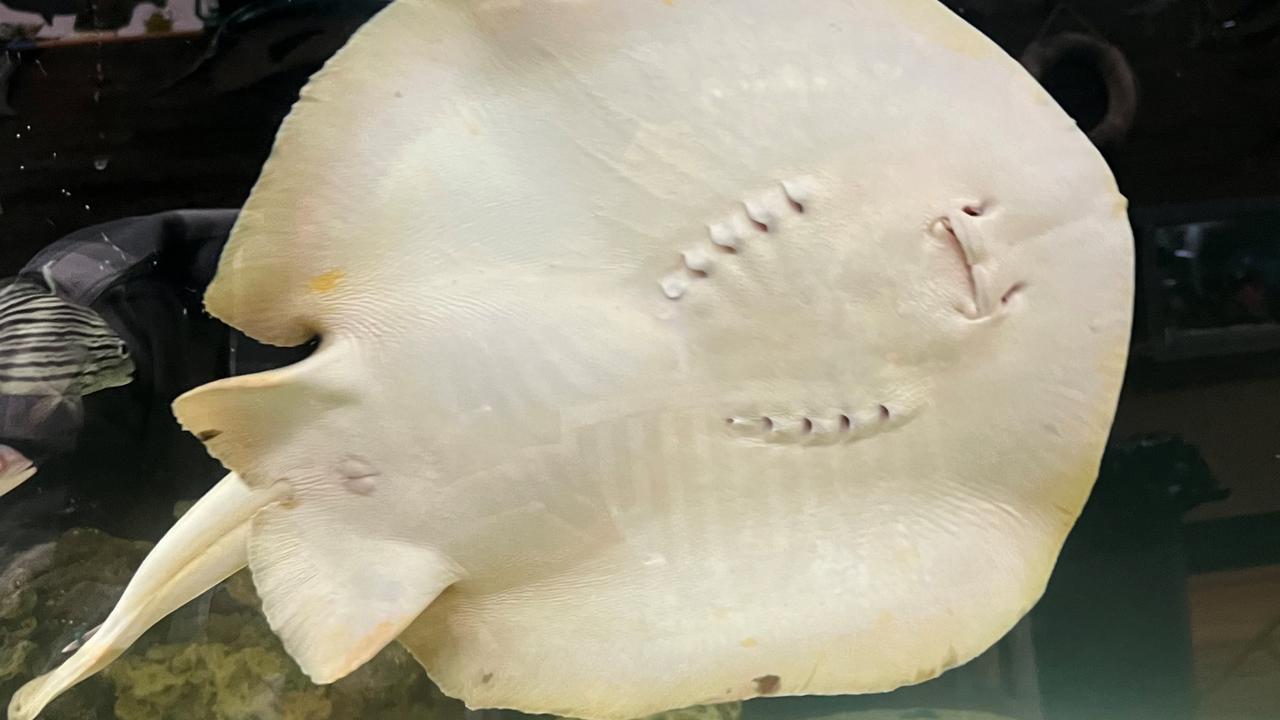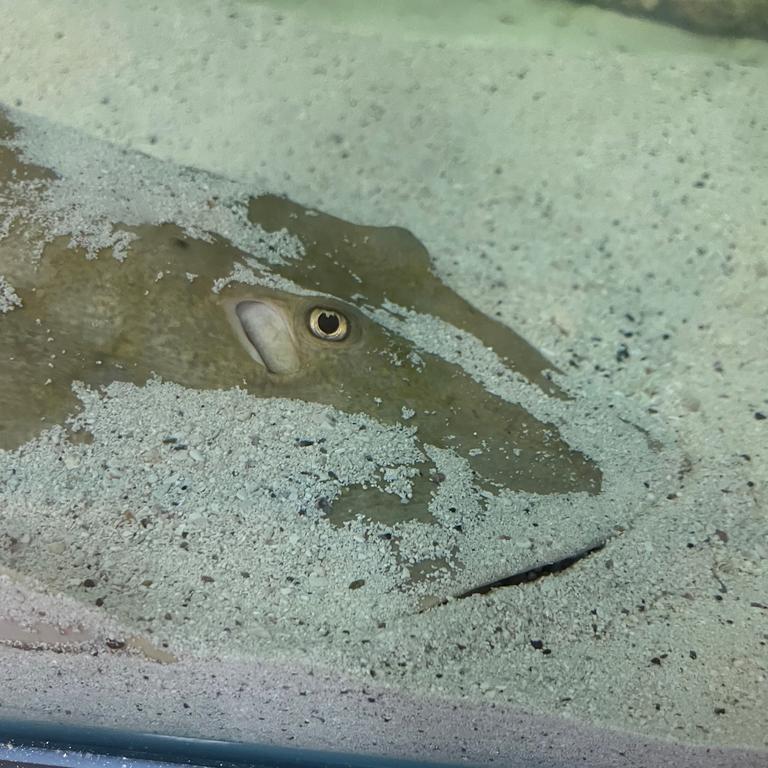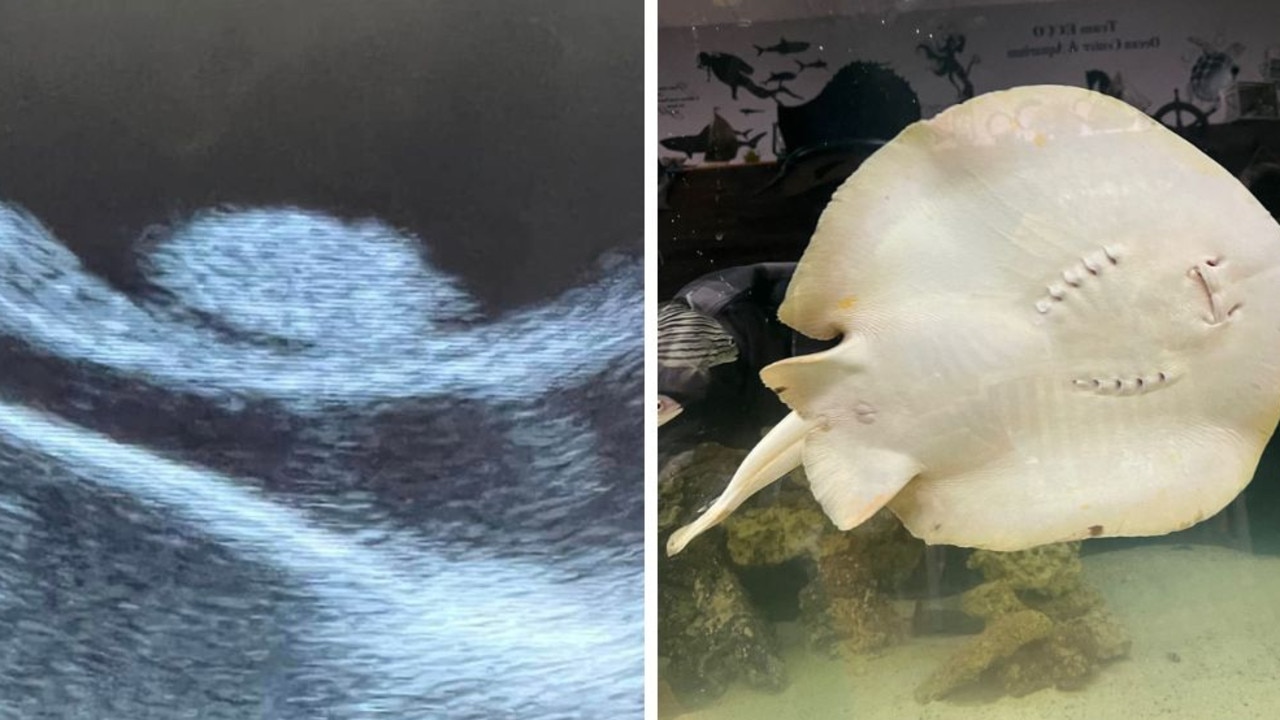‘Nature finds a way’: Stingray becomes pregnant without male
An ultrasound of a stingray has sparked frenzied speculation about how it became impregnated without a male of its species

READING LEVEL: GREEN
Meet Charlotte, a rust-coloured stingray the size of a serving platter, who has spent much of her life gliding around the confines* of a storefront* aquarium in North Carolina’s Appalachian Mountains in the United States.
She’s 3700 km from her natural habitat* under the waves off southern California. And she hasn’t shared a tank of water with a male of her species* in at least eight years.
And yet, nature has found a way, Aquarium and Shark Lab executive director Brenda Ramer said.

Charlotte is pregnant with as many as four pups and could give birth very soon.
The small aquarium is run by Ms Ramer’s educational non-profit, Team ECCO, which encourages local schoolchildren and others to take an interest in science.
Its biggest lesson now is on the process of parthenogenesis: a type of asexual reproduction* in which offspring* develop from unfertilised eggs, meaning there is no genetic contribution* by a male.
The mostly rare phenomenon* can occur in some insects, fish, amphibians*, birds and reptiles*, but not mammals*.

Documented examples* have included California condors*, Komodo dragons* and yellow-bellied water snakes.
Based in Atlanta, Georgia Aquarium research scientist Dr Kady Lyons, who is not involved with the North Carolina aquarium, said Charlotte’s pregnancy is the only documented example she’s aware of for this species, round stingrays.
But Dr Lyons isn’t at all shocked. Other kinds of sharks, skates and rays — a trio of animals often grouped together — have had these kinds of pregnancies in human care.
“I’m not surprised, because nature finds a way of having this happen,” she said.
To be clear, Dr Lyons said, these animals are not cloning* themselves. Instead, a female’s egg fuses with another cell, triggers cell division* and leads to the creation of an embryo*.
The cell that fuses with the egg is known as a polar body*. They are produced when a female is creating an egg that usually wouldn’t be used.
We don’t know why it happens,” Dr Lyons said. “Just that it’s kind of this really neat phenomenon that they seem to be able to do.”

Ms Ramer said she and others at the non-profit at first thought that Charlotte had a tumour* when they noticed a lump on her back that was “blowing up like a biscuit.” But an ultrasound* revealed her pregnancy.
“We were all like, ‘Shut the back door. There’s no way’,” Ms Ramer said. ”We thought we were overfeeding her. But we were overfeeding her because she has more mouths to feed.”
Charlotte currently lives in a tank that’s about 8300 litres, or nearly the size of a skip bin. Ms Ramer said they’re hoping to get a tank nearly twice that size to accommodate Charlotte’s offspring. They also want to put live cameras up for people to see them.
“It is very rare to happen,” Ms Ramer said. “But it’s happening in the middle of the Blue Ridge Mountains in rural North Carolina, hundreds of miles from the ocean.”

As for the suggestion that Charlotte could have been impregnated* by a shark, Dr Lyons said that was impossible. Besides being different sizes, the animals wouldn’t match up anatomically*. Neither would their DNA*.
“We should set the record straight that there aren’t some shark-ray shenanigans happening here,” said Dr Lyons, whose graduate work focused on the species.
Round stingrays like Charlotte are abundant on the Pacific coasts of southern California and Mexico, often resting on the ocean’s sandy bottom near the shoreline.
In the wild they are typically the size of a small dinner plate, and their name comes from their circular shape. They come in all shades of brown. They eat small worms, crabs and molluscs, and they are preyed upon by certain types of sharks, seals and giant sea bass.

They’re well known to humans because of their painful sting but Dr Lyons said the species was fascinating.
For example, embryos in the womb are bathed in uterine milk* that provides nutrients to help them develop.
“I’m glad the round stingray is getting the media attention that it deserves,” Dr Lyons said. “They do a lot of really neat stuff.”
GLOSSARY
- confines: limits or boundaries
- storefront: the front side of a store facing the street
- natural habitat: the environment where an organism normally lives or grows
- species: a group of organisms capable of interbreeding and producing fertile offspring
- asexual reproduction: reproduction without the involvement of a male, without fertilisation
- offspring: the product of reproduction; the young
- genetic contribution: the passing of genetic material from parent to offspring
- rare phenomenon: an unusual occurrence that happens infrequently
- amphibians: a class of cold-blooded vertebrates that includes frogs, toads, and salamanders
- reptiles: a class of cold-blooded vertebrates that includes snakes, lizards, and turtles
- mammals: warm-blooded vertebrates that typically have hair or fur and produce milk
- documented examples: instances that have been recorded or verified
- condors: large birds related to vultures
- Komodo dragons: large lizard species found in Indonesia
- cloning: the process of producing genetically identical individuals
- cell division: the process by which cells divide to form new cells
- embryo: an early stage of development before birth or hatching
- polar body: a small cell produced during the formation of an egg but usually not used
- tumour: an abnormal mass of tissue
- ultrasound: a medical imaging technique using sound waves
- impregnated: to make pregnant
- anatomically: related to the structure of the body
- DNA: deoxyribonucleic acid, the genetic material in living organisms
- uterine milk: a nutrient-rich fluid in the womb that nourishes developing embryos
EXTRA READING
Mogo Wildlife Park welcomes twin lion cubs
How do whales sing underwater?
Great whites’ mystery deep dives
QUICK QUIZ
- What is the process of reproduction mentioned in the story?
- What does the educational non-profit, Team ECCO, encourage schoolchildren to take an interest in?
- Why did Ms Ramer initially think Charlotte had a tumour?
- What is the size of the tank that Charlotte currently lives in?
- According to Dr Lyons, what unique feature do embryos in the womb of round stingrays have?
LISTEN TO THIS STORY
CLASSROOM ACTIVITIES
1. Charlotte’s motherhood journey
If Charlotte had to tell her offspring about how they were made, what might she say?
Write a few paragraphs explaining in kid-friendly language how she managed to get pregnant without a male species of stingray in her tank.
Time: allow 25 minutes to complete this activity
Curriculum Links: English, Science, Personal and Social, Critical and Creative Thinking
2. Extension
How does the Kids News article explain why a shark and a stingray can’t reproduce to make a new species?
Draw a sketch of what a shark/stingray might look like if combined?
VCOP ACTIVITY
Imaginative dialogue
Imagine you were there during the event being discussed in the article, or for the interview.
Create a conversation between two characters from the article - you may need or want to include yourself as one of the characters. Don’t forget to try to use facts and details from the article to help make your dialogue as realistic as possible.
Go through your writing and highlight any punctuation you have used in green. Make sure you carefully check the punctuation used for the dialogue and ensure you have opened and closed the speaking in the correct places.
Time: allow 15 minutes to complete this activity
Curriculum Links: English, Visual Arts, Critical and creative thinking
VCOP ACTIVITY
Up-level it
Scan through the article and see if you can locate three words that you consider to be basic, or low level. These are words we use all the time and that can be replaced by more sophisticated words. Words like “good” and “said” are examples of overused words.
Once you have found them, see if you can up-level them. Think of synonyms you could use instead of these basic words, but make sure they still fit into the context of the article.
Re-read the article with your new words. Did it make it better? Why/why not?

